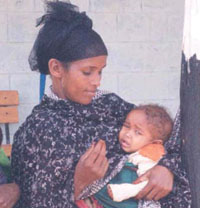Course of malarial disease
Symptoms of malaria usually start to appear 7 to 21 days after the bite of an infected mosquito. However, the normal incubation period is different for different species of Plasmodium, as described in Study Session 5. Remember that the incubation period is the time between the parasite getting into the blood of a person and the onset of symptoms.
Can you recall, from what you learned in Study Session 5, which of the following malaria parasites has the shortest incubation period? Which has the longest?
- Plasmodium falciparum
- Plasmodium vivax
- Plasmodium malariae
- Plasmodium ovale.
P. falciparum has the shortest and P. malariae has the longest incubation period.
A patient who is not treated may develop severe complications and may die, or may continue to have cycles of fever alternating with symptom-free periods. In general, the more Plasmodium parasites there are in the blood, the more severe the disease will be.
Disease progression varies with the parasite species
Disease progression varies according to the species of Plasmodium that has infected the patient. Patients infected with P. vivax, especially for the first time, can be quite ill. However, P. vivax rarely causes complications or results in death. Relapses (return of malaria symptoms due to activation of an old infection) due to P. vivax can occur for several years.
Patients with serious complications are generally referred to a health centre; you will learn how to refer such patients in Study Session 8.
By contrast, P. falciparum is the most lethal form of malaria infection. It causes the most serious complications, which are anaemia (Box 7.1 above) and cerebral malaria. In cerebral malaria, red blood cells infected by the parasite stick to small blood vessels in the brain. This reduces the flow of blood and the supply of oxygen and nutrients to the brain. If untreated, cerebral malaria can kill the patient in 24–48 hours. It most commonly affects young children (Figure 7.2).
